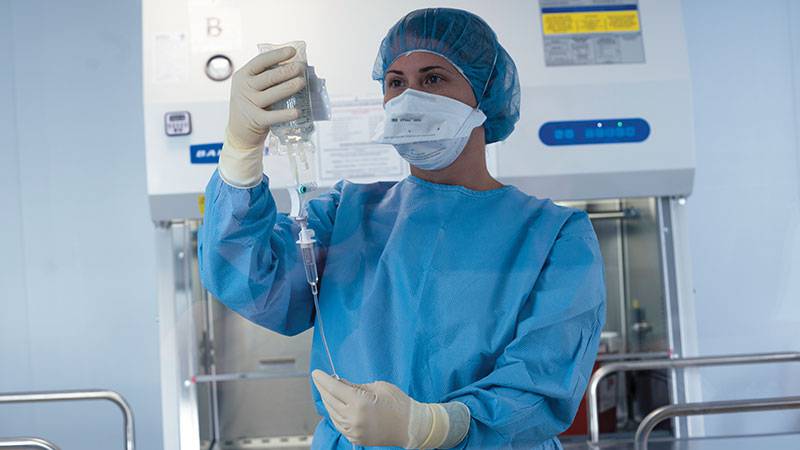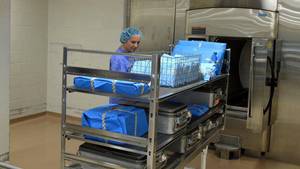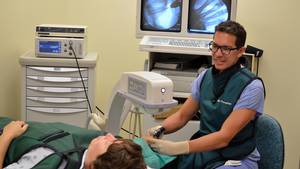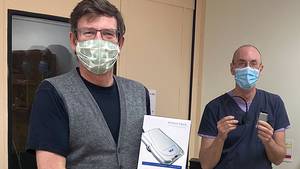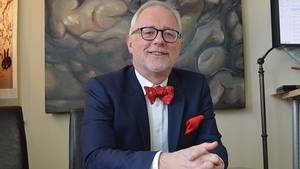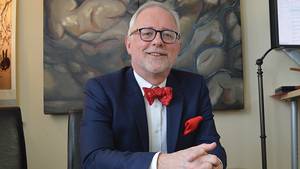Between 100 and 150 lifesaving doses of systemic therapy are prepared for cancer patients at the QEII Health Sciences Centre every day. Now, that crucial work is being done in a new, state-of-the-art cancer therapy preparation lab.
QEII Foundation donors and the BMO Ride for Cancer community stepped up, together contributing $2 million to completely fund the cutting-edge equipment and technology within the leading-edge space. It’s one of many care areas feeling the impact of the QEII Foundation’s $100-million We Are campaign — transforming health care at the QEII Health Sciences Centre and beyond.
The new lab began operations on July 11 after being relocated from the QEII’s Victoria Building to its new home in the Dickson Building. The new lab has significantly increased capacity, which means patients can spend less time waiting for treatment.
“We now have the capacity to double our output,” says Claudia Harding, clinical pharmacy manager for Oncology and Research.
A cancer therapy preparation lab is comparable to a kitchen in a restaurant, but with one crucial difference: No two dishes are the same. Each treatment is carefully calibrated for the individual patient based on numerous factors, including the type, stage and molecular
or genetic features of the cancer as well as the patient’s height, weight, blood cell count and liver and kidney function.
While the previous lab had only two fume hoods — or biological safety cabinets — under which the therapy doses are prepared, the new facility has four. Completely funded by donors and BMO Ride participants, these new fume hoods allow the team of pharmacists and pharmacy practice assistants (PPAs) at the QEII to deliver the lifesaving doses faster and provide new care options for patients and their families.
Approximately 50 per cent of all cancer patients receive systemic therapy — drugs that spread throughout the body to reach cancer cells wherever they may be. Systemic therapy includes a vast array of treatments such as chemotherapy, hormonal therapy, immunotherapy and targeted drugs.
Claudia estimates that between 50 and 60 per cent of all systemic therapy doses delivered in Nova Scotia are prepared and delivered at the QEII.
“We’re the tertiary centre for the province, so patients who require specialized or complicated therapies that can’t be delivered closer to home will come here for treatment,” she says.
Accuracy is critical in systemic therapy, and the new lab will provide an additional layer of safety, with technologies like bar-coding, remote cameras and automation. Scanning the bar codes on every vial before preparation reduces the potential for human error.
“With chemotherapy, you are killing cells that are dividing very quickly, but because of that there are side effects like hair loss and nausea,” Claudia explains. “That’s why it’s critical that the dosage is exactly what is needed, but no more.”
The new facility meets recently updated national standards for preparation labs. It also has improved the workflow, maximizing efficiency.
“When we only had two fume hoods, sometimes there would be bottlenecks,” recalls Jessica Randall, manager, Sterile Pharmacy Operations. “Eventually we would catch up, but it meant that patients would have to wait. The new system allows things to move much more efficiently.”
The new lab will also enable the QEII’s Cancer Centre to participate in new and additional clinical trials, testing more novel therapies to ensure patients in Nova Scotia have access to the latest ground-breaking treatments and opportunities.
“There is a lot of paperwork that comes with clinical trials,” Jessica says. “Everything has to be well-documented, so our new space and improved workflow will definitely increase our capacity to do clinical trials.”
The new, modular space and improved air conditioning have been welcome additions, both for pharmacy team members and staff in the various disciplines involved in preparation and treatment.
“We’ve received great feedback from porters and nurses,” Claudia says. “Everyone is very grateful for the new space.”

